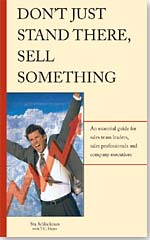Helping Sales Understand Customer Buying Decisions, Part I
Editor’s note: Stu Schlackman is a frequent contributor to this blog.
In Part I of a four part series, Stu reveals the Obective reasons that customers buy. In Part II, he addresses Subjective reasons for customer purchases, while Part III and Part IV detail the personality styles that drive buying decisions.
It’s not what people buy, but why they buy. Your customer’s personality style is a key to understanding the buying decision. A customer has business reasons and personal reasons to seek a new product or service. Additionally, both objective and subjective factors are assessed as the customer decides whether to buy and from which seller. By understanding how the different personality color types influence these decision criteria, you can influence the decision to buy.
Objective reasons to buy
The buying cycle starts with an identified need exists within the buying company. Customers purchase products and solutions to impact specific factors in their business model or to reach specific business goals. Some of the most typical of these are, depending upoon industry and company maturuty:
- Increase profits and revenue
- Reduce operational costs
- Increase productivity
- Improve cash flow
- Reduce inventory
- Improve customer delivery
- Lower product defect rates
- Reduce whole life total cost of ownership of equipment
- Bring new products to market faster
- Open new markets for products
Once the purchase is complete, the impact on these factors is both objective and measurable. For the purchase to be successful, some measurable and beneficial shift must be observed. But at the time of the decision to buy, these are “potential” effects and the salesman can influence the perception of how the product will perform.
Five common criteria weighed by the purchasing team, when making a decision to buy a product or service, are cost, capability, quality, service and risk. Whether it’s a product or a project, these are key factors your customers consider when making a decision. Cost is the Total Cost of Ownership including the return on the investment. This TCO includes the immediate price, the deferred downstream costs such as maintenance and service, and indirect costs such as any warranties involved.
Objective buying-decision criteria
- Capability is the functionality of your product or service and the technology that’s used. “What is the product or service able to do?” “What’s the breadth of the solution and how can it expand in the future as we grow?” “How easy will it be to install and integrate with other parts of our business process?”
- Quality is the reliability of your product. “Will it last?” “Will it have problems?” “Will it consistently perform as promised?”
- Service is how well you will take care of the customer if problems arise. “What hours are you available?” “What is your response time?” Service is all about your company’s attitude on customer care and your ability to perform when issues arise.
- Risk measures the probability that you will live up to your agreements, direct and implied, and additionally that the product is all they expect it to be. Some risk is inherent in any decision to buy or not to buy. Have they learned enough to be comfortable with a decision to purchase? Will their risk be reduced if they wait and weigh more issues and look at more products? Will the solution perform as promised and will the return on investment be what was expected?
Each of the four personality styles, as they consider the solution you are offering, will give a different weighting to each of these criteria. In Part II, we’ll look at the subjective factors.

